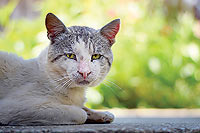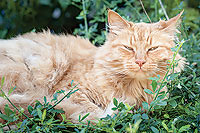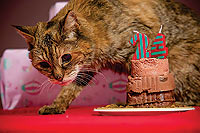Fortunately, we’re learning more every day about helping aging kitties stay healthy. Since there are nearly 60 million pet cats in the U.S., many of them well past the average age of 12-14 years there are many homes that have a senior cat. Cats are masters at hiding pain and discomfort so it takes some extra observation and knowledge to keep your fluffy house monster in prime condition.
Cognitive Decline in Cats: Common, but Not Inevitable
One of the main concerns that people with aging cats have is the behavior and personality changes they observe in their furry family members. Like humans, cats can experience age-related mental changes as they get older, and if the changes are mild, they’re generally considered normal and no cause for concern. However, there are also changes that signal a potentially more serious issue.

If you’re a pet parent, it’s important to understand that serious cognitive decline in cats is relatively common, and that cognitive impairment is neither a normal part of aging, nor is it inevitable. It’s equally important to know that effective preventives and treatments may be available. Simply attributing behavior changes in your cat to old age can prevent the diagnosis of a potentially treatable condition.
Research shows that over a quarter of cats aged 11 to 14 years and 50% of cats 15 years and older exhibit symptoms of serious cognitive decline. And according to some experts, these numbers may be on the low end of the actual number of cats suffering mental decline.
While dogs have been the subject of most scientific research on mental decline, interest in the topic as it relates to cats is growing. Toward that end, researchers are using feline-specific behavior assessments and conducting studies focused on brain tissue changes linked to changes in cognition.
7 Signs of Cognitive Decline in Cats
Diagnosing cognitive decline in cats requires a complete physical exam to look for other conditions that can either mimic cognitive decline or influence the diagnosis. Diseases that can affect your cat’s behavior include diabetes, hyperthyroidism, urinary tract disease and skin disease. Signs to look for, which now go by the acronym VISHDAAL (formerly DISH), are:
• Increased or unusual Vocalization (especially at night)
• Changes in Interactions with owners and other household pets
• Sleep/wake cycle disturbances
• House soiling
• Disorientation or confusion
• Activity changes, such as aimless wandering
• Learning and memory lapses
If you notice any of these signs, it’s important to make an appointment with your veterinarian so they can check for underlying diseases that may be contributing to your cat’s behavior changes.
Provide a Good Quality of Life for Your Aging Cat
The good news is that early intervention for cats with cognitive decline can improve their long-term prognosis. Even better news is that if your kitty has suffered cognitive decline, there are still things you can do to improve your pet’s mental well-being and slow further progression.
Periodic detoxification with milk thistle, superoxide dismutase (SOD) and dandelion can also be very beneficial, as can providing super green foods in the form of fresh “cat grass” to nibble on. Chlorophyll, chlorella, or spirulina can also be offered in supplement form to enhance your cat’s detoxification processes.
For aging kitties who prowl the house at night and vocalize, consider a CBD product designed for cats that not only has a calming effect, but can help with pain. You can also use rhodiola, valerian, chamomile, and l-theanine with good results in restless cats. Always make sure you check your cat’s thyroid function if you notice an increase in nighttime activity and vocalizations prior to starting supplements.
Provide a nutritionally optimal, species-specific diet — Contrary to what many cat parents and even veterinarians believe, aging pets need more healthy protein than their younger counterparts, and the quality is extremely important. The more digestible and assimilable the protein is, and the higher the moisture content of the food, the easier it will be for aging organs to process. If you haven’t slowly swapped your kibble for more moisture-dense food, the sooner you do this, the healthier your cat of any age will be.
Feed your cat a nutritionally balanced, antioxidant rich, carnivore-friendly diet that includes omega-3 essential fats such as fish oil, which helps nourish the brain. Allow them to fulfill their drive to hunt prey by offering them an indoor hunting feeder containing small amounts of freeze-dried meat treats. Make sure meals are provided on a consistent schedule, along with playtime and petting/lap time.
Be sure to encourage water-drinking by offering your cat a variety of stainless-steel or ceramic water bowls around the house or even a drinking fountain, in addition to minimizing or (preferably) eliminating dry food. If they’re addicted to a poor-quality processed diet and efforts to upgrade the food they eat has failed, consider adding additional moisture to their food in the form of salt-free bone broth.
Provide opportunities for physical and mental stimulation — Keep your cat’s body and mind active with regular exercise appropriate for their age and physical condition (feather toys may still be engaging), and mental stimulation (treat-release toys hidden around the house can be beneficial). Organic catnip or silver vine can be a very effective way to encourage your cat to play.
Think of creative ways to enrich your cat’s indoor environment and if they never touch the earth’s surface directly (most housecats don’t), consider a grounding pad to help reduce the buildup of EMFs (electromagnetic fields). Often when a grounding mat is available cats will be attracted to it.

Regular massage can help keep your senior cat’s muscles toned and reduce the slackening that comes with aging. Massaged muscles are looser, which makes it easier for pets to move around comfortably. Massage also improves circulation, encourages lymphatic drainage, and eases joint stiffness and is something you can learn to do at home.
Provide comfort for an aging body — If your cat seems physically uncomfortable, it’s important not to assume it’s just a natural part of aging. You want to make sure they’re not in pain, so a visit to your veterinarian is needed. The sooner a health problem is diagnosed and treated, in most cases, the better the outcome.
Keeping your cat at a good weight and physically active will help control arthritis and degenerative joint disease as they age. Chiropractic adjustments and acupuncture can also be very helpful in keeping them fully mobile in their later years.
There are a wide range of supplements that can be added to your cat’s diet to help maintain healthy tendons, ligaments, joints, and cartilage, as well and being anti-inflamitory:
• Glucosamine sulfate with MSM
• Eggshell membrane
• Green lip mussels (naturally high in glucosamine
and taurine)
• Omega-3 fats (fish) reduce inflammation
• Herbs, including boswellia and cat’s claw blends
• Palmitoylethanolamide (“PEA”)
• Full spectrum hemp or CBD oil
Also ensure your cat can get into and out of the litterbox easily and monitor litter box habits daily. Remember that kitties are very adept at hiding arthritis and other aches and pains, which can limit their ability to climb into high-sided boxes, or boxes kept in bathtubs or up a flight of stairs, for example.
Spend time with your cat every day — Set aside time each day to hang out with your kitty. If they tolerate being brushed or combed, work that into the daily schedule as well, to help them with grooming chores. Trimming the hair around the perineal area is usually much appreciated by older cats.
Dog-Friendly Walks/Hikes
in the Moab Area |
Corona Arch - Easy/Moderate. 1.3 Miles one way. Trailhead is 25 minute drive from Moab.
North on US-191 to Potash Road (Utah 279).
Mill Creek Pathway - Easy. 1.1 Miles. Little to no driving. Starts at the intersection of 100 South and 100 West,
a block off of Main Street.
Portal Overlook - Hard. 2.0 Miles one way. Trailhead is 20 minute drive from Moab.
North on US-191 to Potash Road (Utah 279).
Grandstaff Canyon - Moderate. 2.0 Miles one way. Trailhead is 10-minute drive from Moab.
North on US-191 to the River Road (Utah 128) |
|